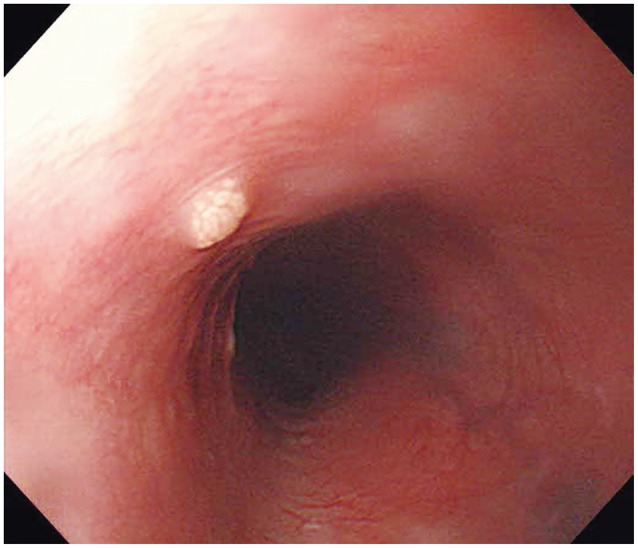Clin Endosc.
2014 Jul;47(4):358-361. 10.5946/ce.2014.47.4.358.
Xanthoma of the Esophagus
- Affiliations
-
- 1Department of Internal Medicine, Hallym University College of Medicine, Chuncheon, Korea. kimyeonsoo@hallym.or.kr
- 2Department of Pathology, Hallym University College of Medicine, Chuncheon, Korea.
- KMID: 1907939
- DOI: http://doi.org/10.5946/ce.2014.47.4.358
Abstract
- Xanthoma is an uncommon nonneoplastic lesion resulting from the accumulation of histiocytes. It predominantly shows cutaneous manifestations associated with dyslipidemia. However, xanthoma of the esophagus is extremely rare. To the best of our knowledge, only 14 cases have been reported thus far. The clinical significance of this lesion has not been established. However, this lesion should be distinguished grossly from ectopic sebaceous glands and small subepithelial tumors such as carcinoid and granular cell tumor. Moreover, signet ring cell carcinoma, which contains round cells with abundant cytoplasm and has similar histologic features to xanthoma, should be distinguished microscopically.
Keyword
MeSH Terms
Figure
Cited by 1 articles
-
Magnifying Endoscopy for Esophageal Ectopic Sebaceous Glands
Mu Song Jeon, Gwang Ha Kim, Dong Young Jeong, Byeong Kyu Park, Moon Won Lee, So-Jeong Lee, Do Youn Park
Clin Endosc. 2018;51(5):495-497. doi: 10.5946/ce.2017.187.
Reference
-
1. Gencosmanoglu R, Sen-Oran E, Kurtkaya-Yapicier O, Tozun N. Xanthelasmas of the upper gastrointestinal tract. J Gastroenterol. 2004; 39:215–219. PMID: 15064997.
Article2. Remmele W, Engelsing B. Lipid island of the esophagus. Case report. Endoscopy. 1984; 16:240–241. PMID: 6510370.3. Stolte M, Seifert E. Lipid islands in the esophagus. Leber Magen Darm. 1985; 15:137–139. PMID: 4058227.4. Vimala R, Ananthalakshmi V, Murthy M, Shankar TR, Jayanthi V. Xanthelasma of esophagus and stomach. Indian J Gastroenterol. 2000; 19:135. PMID: 10918723.5. Hirokawa M, Takenaka R, Takahashi A, et al. Esophageal xanthoma: report of two cases and a review of the literature. J Gastroenterol Hepatol. 2003; 18:1105–1108. PMID: 12911673.
Article6. Cho DS, Park HK, Park SK, et al. An esophageal xanthoma diagnosed by upper gastrointestinal endoscopy. Korean J Med. 2008; 75(Suppl 3):S784–S786.7. Arima M. Esophageal xanthoma: report of two cases. Stomach Intest. 2008; 43:317–320.8. Becheanu G, Dumbrava M, Arbanas T, Diculescu M, Hoyeau-Idrissi N, Fléjou JF. Esophageal xanthoma: report of two new cases and review of the literature. J Gastrointestin Liver Dis. 2011; 20:431–433. PMID: 22187711.9. Park HS, Jang KY, Moon WS. Incidental esophageal xanthoma in a patient with ileocecal lymphoma. Dig Endosc. 2013; 25:92–93. PMID: 23286271.
Article10. Herrera-Goepfert R, Lizano-Soberón M, García-Perales M. Verruciform xanthoma of the esophagus. Hum Pathol. 2003; 34:814–815. PMID: 14506645.
Article11. Licci S, Campo SM, Ventura P. Verruciform xanthoma of the esophagus: an uncommon entity in an unusual site. Endoscopy. 2010; 42(Suppl 2):E330. PMID: 21170833.
Article12. Min KW, Koh JS, Lee KG, Kim HC, Jang KS, Paik SS. Verruciform xanthoma arising in the mid esophagus. Dig Endosc. 2012; 24:387. PMID: 22925303.
Article
- Full Text Links
- Actions
-
Cited
- CITED
-
- Close
- Share
- Similar articles
-
- A Case of Type IV Hyperlipoproteinemia with Palmar Xanthoma, Tuberous Xanthoma, and Eruptive Xanthoma
- A Case of Type IIb Hyperlipoproteinemia with Xanthoma Tuberosum, Xanthoma Planum and Xanthoma Striatum Palmare
- Two Cases of Diffuse Plane Xanthoma
- Bladder Xanthoma
- A Case of Verruciform Genital-associated (Vegas) Xanthoma on the Scrotum



